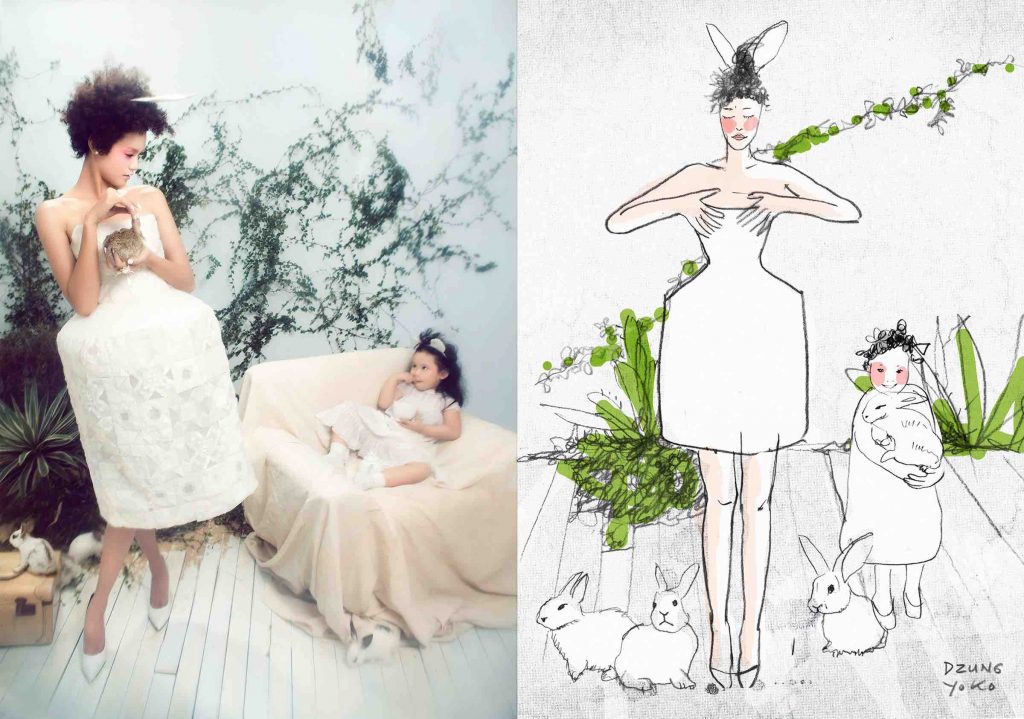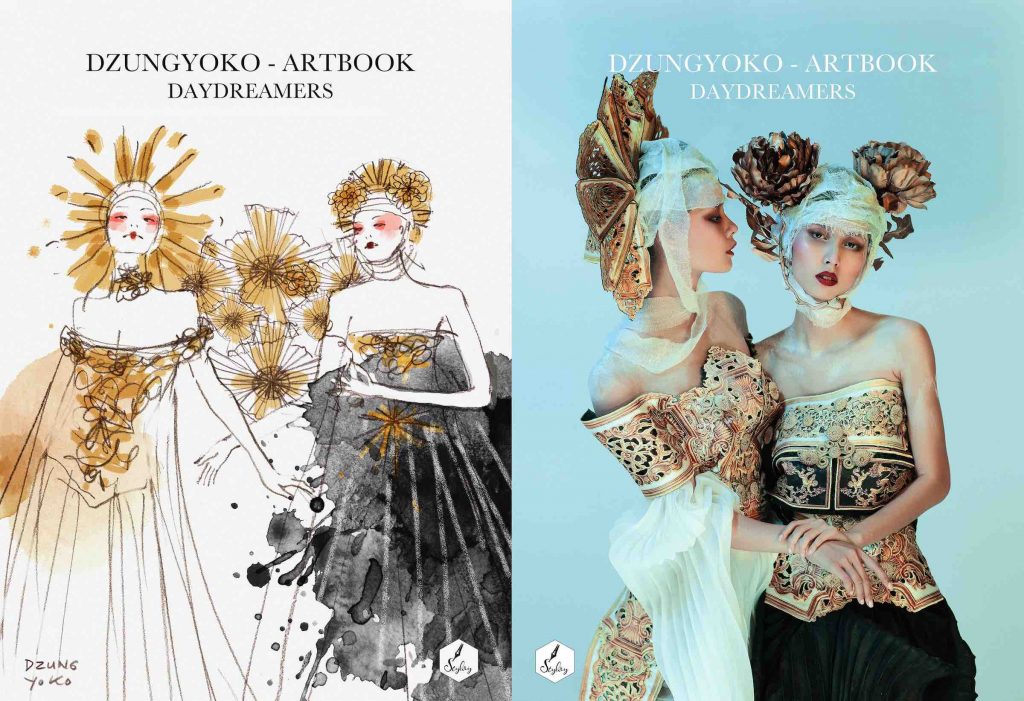Dzung Yoko (real name: Tran Hoang Dung) is often considered to be one of Vietnam’s top visual artists.
Born in 1974 in Saigon, Dzung graduated at the top of his class from the University of Architecture in 1988. He went on to become a graphic designer with album cover designs for renowned Vietnamese artists such as Tran Thu Ha, Do Bao, Tung Duong, etc. His experience with these covers, and exposure to the world of high fashion through the works of world-famous British photographer Tim Walker, eventually led Dzung to become the creative director of Elle Vietnam, and now the art director of L’Officiel Vietnam.
Regarded as one of the most influential figures in the Vietnamese fashion industry, Dzung recently published his first fashion book titled “Daydreamers”, featuring eleven of his best photo shoots and their concept sketches. Dzung’s works are often known for their distinct style, often taking wide-ranging influences from historical or fantasy settings, with a strong sense of storytelling.
If a six-year old asked you about what you do for a living, how would you answer?
Dzung Yoko: I’d say that my job is to come up with beautiful things that tell stories and make people feel inspired.
And how is it different from other creative professions?
DY: I often blend in my own dreams and experiences with the stories that I tell. As the creative director of a fashion magazine, I want to craft image-based stories that explain to people the fascinating art behind fashion products.
As a graduate in architecture, how did you get into fashion?
DY: I graduated at the top of my class, and could have stayed at the university to become a lecturer and then take up a Master’s degree.
However, it turned out that I didn’t want to work in architecture! Then I took up graphic design and illustration. In 2011, I became enamored with the world of fashion, and realize that it’s a very advanced art form that inspires a passion for life. Most people think of fashion as something vain and hedonistic, but behind each and every product is a collective dream of many artists who want to make life and people more beautiful.
Art is a personal thing, and everyone has his own take on it. As a devoted aesthete, I always want to create dreamy and otherworldly images, which evoke nostalgia or escapism in people.

How has the nature of your work changed over time?
DY: Back in my graphic design days, I just created works for my own enjoyment. When I designed CD covers, I spent a lot of time listening to each album to figure out how to tell its story via images. Nowadays, I’m still the one that comes up with ideas and stories, but I became more like a film director who has to collaborate with a team of models, stylists, hairdressers, make-up artists, production designers, photographers and assistants to bring those ideas into reality.
I used to work on a whim, but now I realize that art also requires a lot of discipline in addition to talent and passion.
What is your working style?
DY: Each photoshoot usually takes one month, from idea generation to final delivery. The first step always involves sketching. Sketching is my mainstay. When I first started in this job, I didn’t sketch much, and that turned out to be a problem for communication with others. With a sketch, my team can understand what I want: setting, outfit, lighting, pose, etc.
That’s a very scientific way of working, and it also gives me a lot of inspiration: whenever I sketch, I feel free and unbounded by things such as budget or where can we get the props from.
At the same time, the sketch is meant to be an initial idea and not a strict requirement for the final work. A photograph requires inputs from other people so it can have a life and a soul of its own.

What is the best thing you have learned from your work?
DY: Through my work, I’ve grown up and learned some of life’s important lessons: be patient; set your creativity free; be persistent in the quest to create the most beautiful things you can dream of; how to work in a team and inspire others. Just do everything you love without asking for anything in return, and all the rest will follow.
For someone who works with celebrities all the time, you seem to prefer to keep a very low profile. In fact, you haven’t had a press interview for years. Why is it so?
DY: As an artist, I’d like my creations to speak for myself.
How do you come up with new ideas?
DY: I look for new ideas from everyday life, and I think it’s important to have an open mind and a broad view of the world. I’ve found ideas and inspirations from conversations, movies, books and even my own dreams. Watching, reading and traveling a lot provide me with influences from different cultures and countries, and helps me come up with new ideas quickly. I always tell the younger generations to do those things, even to love different people if possible.
You have to open up yourself to the world. If you’re afraid of failure or not being loved, that will be a huge constraint on your creativity.

What would you do if you have to come up with a new idea in 24 hours?
DY: Even if the deadline is approaching quickly, I’ll always set aside some time in the morning for a hot cup of tea next to my window. That’s when my mind calms down and begins to search within my memories for the right idea. Afterwards, I go searching some more on the Internet for further details on the idea. Don’t hurry too much, because that means you will skip over some of the finer details or ideas.
As a well-traveled man, what are your favorite cities?
DY: I love Paris, especially the Saint Germain area in the Latin Quarter, where there’s a lot of bookshops and cafes, and not a lot of tourists. There, I can browse books, sit down with a cup of tea and watch people strolling around. I also like Taipei, a peaceful city with a lot of trees and nice people. It’s not a very special city, but it just makes me feel warm and cozy over there.
Your works often feature different historical settings. If you’re given a one-way ticket for time travel, would you take up the offer and where would you go?
DY: If that’s a one-way ticket, then I won’t take up the offer – I’ve got so much interesting work to do here. But if that’s a return ticket, then I would venture back to the time of the Tang Dynasty in China. It’s my dream, and I often think about it from time to time.

Who is your idol at the moment?
DY: My idol is a British photographer named Tim Walker. His works are just incredible, and make me wonder how someone can come up with ideas so dreamy and surreal. His fashion taste is also very closer to mine. In fact, the very first book about fashion that I bought was about Tim Walker! I bought it in Thailand back in 2008, and it left such a strong impression on me that I think I got the idea to work in the fashion business from that book.
What would be the first question you ask Walker if you have the opportunity to meet him right now?
DY: I’d ask: “Can I just be your assistant for a while?”.
Looking back at your past, do you think your architecture degree has been of any help to your career?
DY: It gave me a strong aesthetic mindset, and a multidimensional, spatial-oriented way of thinking. It also provided me with an understanding of history, and that’s why my work is often related to historical settings and spaces. At first, I often felt regretful that I should have studied graphic design or fashion from the very beginning like some of my friends. But then, I realized that it was my unorthodox and different approach to these fields that helped me.
What made you decide to publish your very first book “Daydreamers” recently?
DY: I’ve been thinking about that for a long time, and then last June I happened to come into contact with a publisher in Hanoi.
Have you ever thought that your life seems to resemble a series of coincidences?
DY: It is nothing but coincidences. I’ve never planned for what I want to do in my life. All the things that happened to me were almost always coincidental. At the same time, I also had to look for those coincidences, not by waiting for them, but by dreaming and thinking about the things that I love every day. If I keep doing that, one day they will become reality.
If a fortune teller offers to let you see into your future, would you take it up?
DY: No, I wouldn’t. I prefer to discover and experience my future on my own.
You look incredibly young for a man in his early forties. What are your secrets?
DY: I think that’s because I don’t think much about calculations, about rewards and losses. I also don’t envy and compare myself with others. I also practice yoga regularly too. I used to spent an hour a day for yoga, and now I only need about 20 minutes.
This is the last, but not least, question.
A few decades ago, NASA had this very interesting idea of making a Golden Record for the two Voyager spaceships, which was basically mankind’s ultimate mixtape: the finest of our arts and culture in one single disc. Those spaceships were sent to the farthest corners of the universe, with the hope of meeting the aliens one day and present to them about humanity. If you were allowed to choose three things that best represent Vietnam to the aliens, what would you choose?
DY: The first thing would be a bowl of “cá kho tộ” (braised fish), to represent Vietnamese cuisine. For the second thing, I’d like a photo of a child, to represent the Vietnamese people.
Finally, the last one would be the image of a typical Saigon alleyway, because so many interesting stories came from such places.
Photos graciously provided by Dzung Yoko
